Business Law 1 Assignment: Contract Law, Agency, and Legality
VerifiedAdded on 2020/02/24
|10
|3209
|38
Homework Assignment
AI Summary
This business law assignment addresses several key concepts within contract law and agency relationships. It begins by defining the components of a binding contract, including offer and acceptance, intent to create a legal relation, consideration, contractual capacity, and legality. The assignment then explores whether a contract must be in writing, discussing the Statute of Frauds and the preference for written contracts in court. It also defines formal contracts, providing examples like bank checks and land transfer contracts. Furthermore, the assignment analyzes a scenario involving friends and the intent to create a legal relation, drawing parallels to case law such as Simpkins v. Pays. Finally, it distinguishes between an agent and an independent contractor, highlighting the legal implications of each relationship, including the level of control and liability involved.
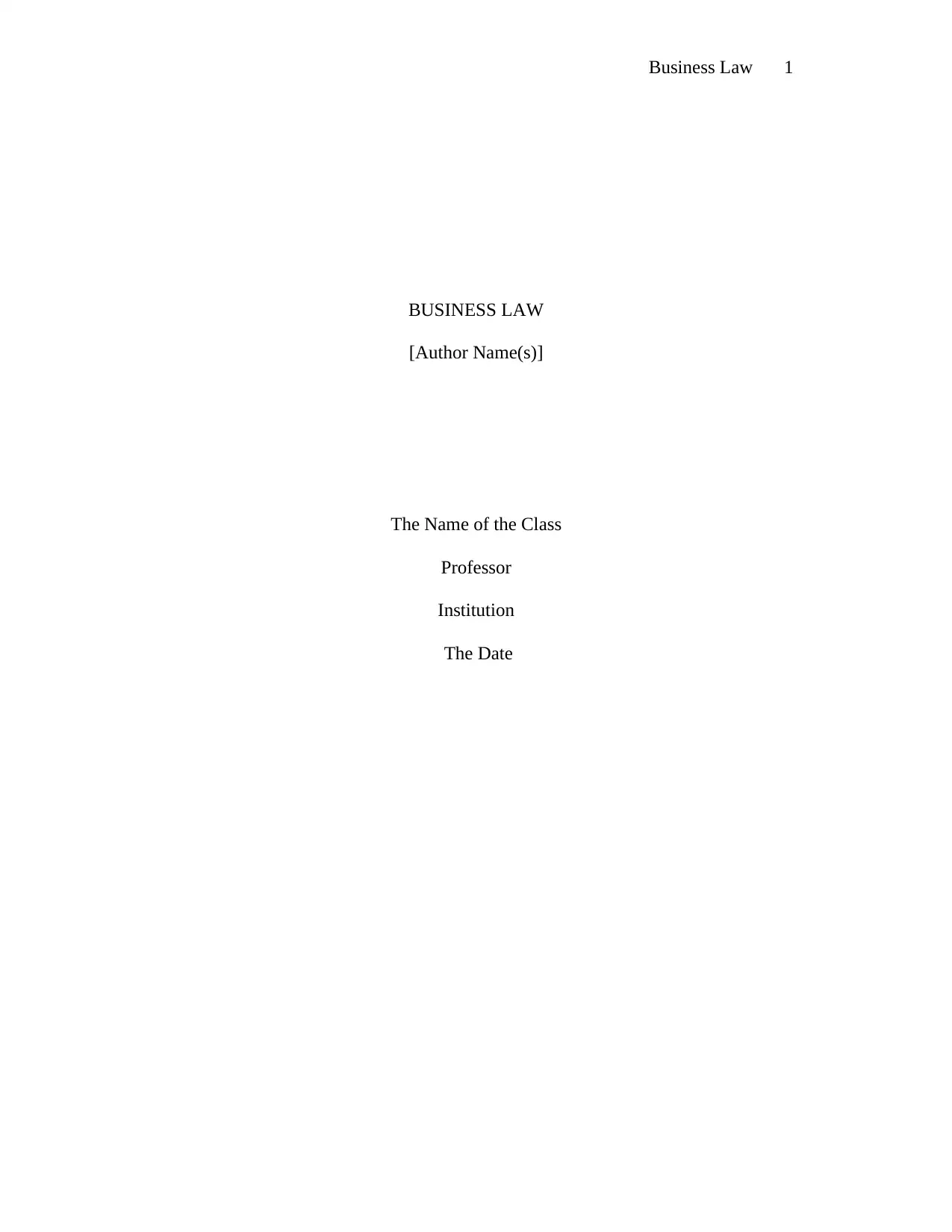
Business Law 1
BUSINESS LAW
[Author Name(s)]
The Name of the Class
Professor
Institution
The Date
BUSINESS LAW
[Author Name(s)]
The Name of the Class
Professor
Institution
The Date
Paraphrase This Document
Need a fresh take? Get an instant paraphrase of this document with our AI Paraphraser
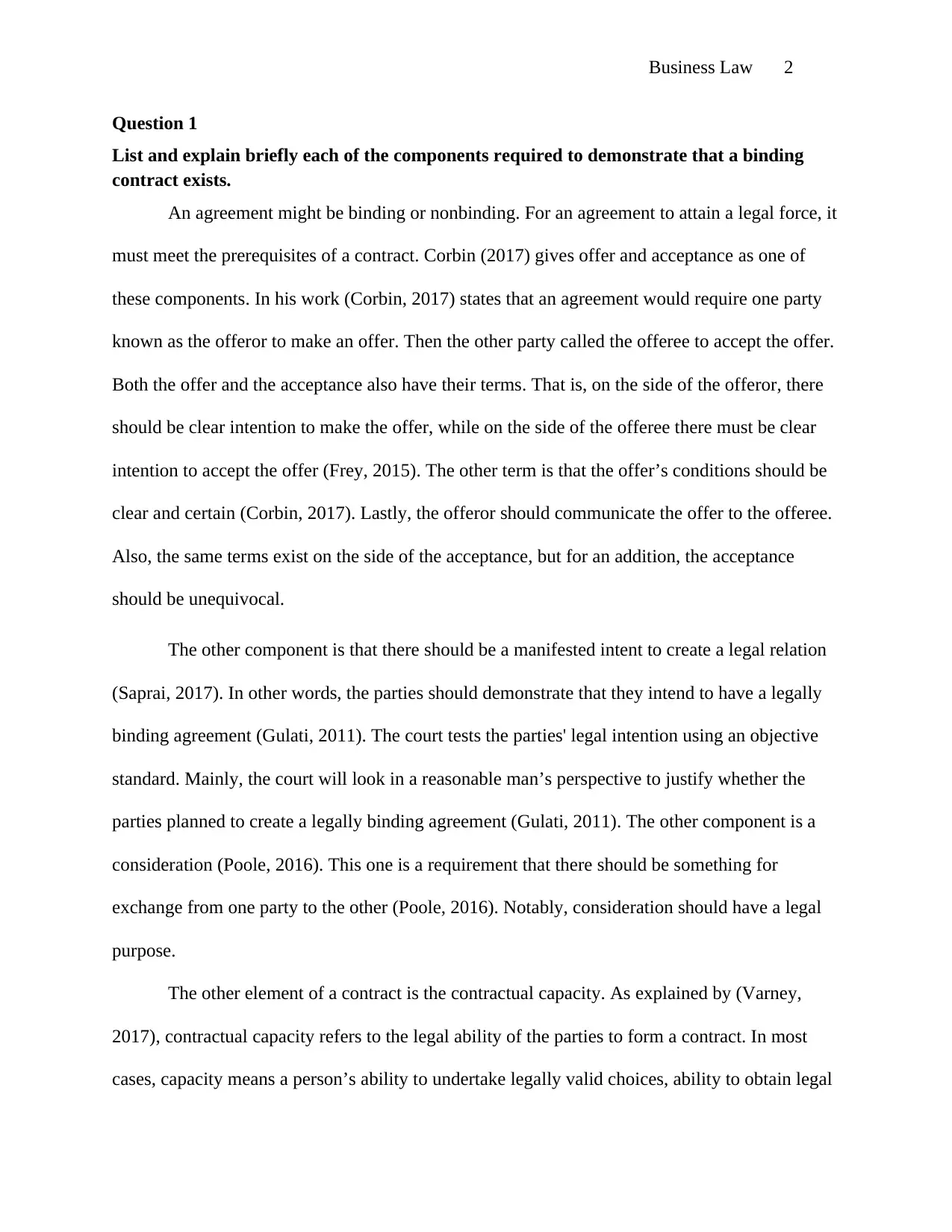
Business Law 2
Question 1
List and explain briefly each of the components required to demonstrate that a binding
contract exists.
An agreement might be binding or nonbinding. For an agreement to attain a legal force, it
must meet the prerequisites of a contract. Corbin (2017) gives offer and acceptance as one of
these components. In his work (Corbin, 2017) states that an agreement would require one party
known as the offeror to make an offer. Then the other party called the offeree to accept the offer.
Both the offer and the acceptance also have their terms. That is, on the side of the offeror, there
should be clear intention to make the offer, while on the side of the offeree there must be clear
intention to accept the offer (Frey, 2015). The other term is that the offer’s conditions should be
clear and certain (Corbin, 2017). Lastly, the offeror should communicate the offer to the offeree.
Also, the same terms exist on the side of the acceptance, but for an addition, the acceptance
should be unequivocal.
The other component is that there should be a manifested intent to create a legal relation
(Saprai, 2017). In other words, the parties should demonstrate that they intend to have a legally
binding agreement (Gulati, 2011). The court tests the parties' legal intention using an objective
standard. Mainly, the court will look in a reasonable man’s perspective to justify whether the
parties planned to create a legally binding agreement (Gulati, 2011). The other component is a
consideration (Poole, 2016). This one is a requirement that there should be something for
exchange from one party to the other (Poole, 2016). Notably, consideration should have a legal
purpose.
The other element of a contract is the contractual capacity. As explained by (Varney,
2017), contractual capacity refers to the legal ability of the parties to form a contract. In most
cases, capacity means a person’s ability to undertake legally valid choices, ability to obtain legal
Question 1
List and explain briefly each of the components required to demonstrate that a binding
contract exists.
An agreement might be binding or nonbinding. For an agreement to attain a legal force, it
must meet the prerequisites of a contract. Corbin (2017) gives offer and acceptance as one of
these components. In his work (Corbin, 2017) states that an agreement would require one party
known as the offeror to make an offer. Then the other party called the offeree to accept the offer.
Both the offer and the acceptance also have their terms. That is, on the side of the offeror, there
should be clear intention to make the offer, while on the side of the offeree there must be clear
intention to accept the offer (Frey, 2015). The other term is that the offer’s conditions should be
clear and certain (Corbin, 2017). Lastly, the offeror should communicate the offer to the offeree.
Also, the same terms exist on the side of the acceptance, but for an addition, the acceptance
should be unequivocal.
The other component is that there should be a manifested intent to create a legal relation
(Saprai, 2017). In other words, the parties should demonstrate that they intend to have a legally
binding agreement (Gulati, 2011). The court tests the parties' legal intention using an objective
standard. Mainly, the court will look in a reasonable man’s perspective to justify whether the
parties planned to create a legally binding agreement (Gulati, 2011). The other component is a
consideration (Poole, 2016). This one is a requirement that there should be something for
exchange from one party to the other (Poole, 2016). Notably, consideration should have a legal
purpose.
The other element of a contract is the contractual capacity. As explained by (Varney,
2017), contractual capacity refers to the legal ability of the parties to form a contract. In most
cases, capacity means a person’s ability to undertake legally valid choices, ability to obtain legal
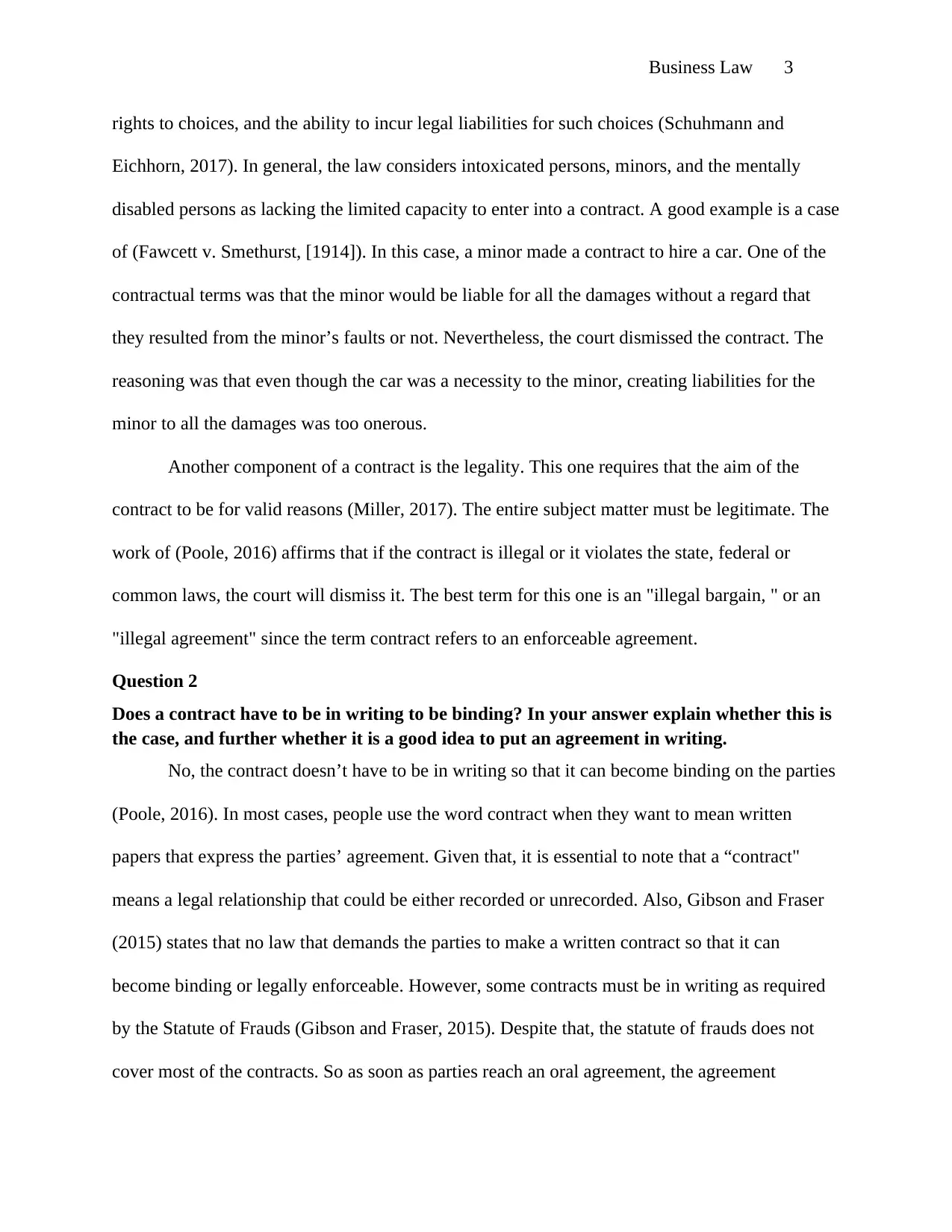
Business Law 3
rights to choices, and the ability to incur legal liabilities for such choices (Schuhmann and
Eichhorn, 2017). In general, the law considers intoxicated persons, minors, and the mentally
disabled persons as lacking the limited capacity to enter into a contract. A good example is a case
of (Fawcett v. Smethurst, [1914]). In this case, a minor made a contract to hire a car. One of the
contractual terms was that the minor would be liable for all the damages without a regard that
they resulted from the minor’s faults or not. Nevertheless, the court dismissed the contract. The
reasoning was that even though the car was a necessity to the minor, creating liabilities for the
minor to all the damages was too onerous.
Another component of a contract is the legality. This one requires that the aim of the
contract to be for valid reasons (Miller, 2017). The entire subject matter must be legitimate. The
work of (Poole, 2016) affirms that if the contract is illegal or it violates the state, federal or
common laws, the court will dismiss it. The best term for this one is an "illegal bargain, " or an
"illegal agreement" since the term contract refers to an enforceable agreement.
Question 2
Does a contract have to be in writing to be binding? In your answer explain whether this is
the case, and further whether it is a good idea to put an agreement in writing.
No, the contract doesn’t have to be in writing so that it can become binding on the parties
(Poole, 2016). In most cases, people use the word contract when they want to mean written
papers that express the parties’ agreement. Given that, it is essential to note that a “contract"
means a legal relationship that could be either recorded or unrecorded. Also, Gibson and Fraser
(2015) states that no law that demands the parties to make a written contract so that it can
become binding or legally enforceable. However, some contracts must be in writing as required
by the Statute of Frauds (Gibson and Fraser, 2015). Despite that, the statute of frauds does not
cover most of the contracts. So as soon as parties reach an oral agreement, the agreement
rights to choices, and the ability to incur legal liabilities for such choices (Schuhmann and
Eichhorn, 2017). In general, the law considers intoxicated persons, minors, and the mentally
disabled persons as lacking the limited capacity to enter into a contract. A good example is a case
of (Fawcett v. Smethurst, [1914]). In this case, a minor made a contract to hire a car. One of the
contractual terms was that the minor would be liable for all the damages without a regard that
they resulted from the minor’s faults or not. Nevertheless, the court dismissed the contract. The
reasoning was that even though the car was a necessity to the minor, creating liabilities for the
minor to all the damages was too onerous.
Another component of a contract is the legality. This one requires that the aim of the
contract to be for valid reasons (Miller, 2017). The entire subject matter must be legitimate. The
work of (Poole, 2016) affirms that if the contract is illegal or it violates the state, federal or
common laws, the court will dismiss it. The best term for this one is an "illegal bargain, " or an
"illegal agreement" since the term contract refers to an enforceable agreement.
Question 2
Does a contract have to be in writing to be binding? In your answer explain whether this is
the case, and further whether it is a good idea to put an agreement in writing.
No, the contract doesn’t have to be in writing so that it can become binding on the parties
(Poole, 2016). In most cases, people use the word contract when they want to mean written
papers that express the parties’ agreement. Given that, it is essential to note that a “contract"
means a legal relationship that could be either recorded or unrecorded. Also, Gibson and Fraser
(2015) states that no law that demands the parties to make a written contract so that it can
become binding or legally enforceable. However, some contracts must be in writing as required
by the Statute of Frauds (Gibson and Fraser, 2015). Despite that, the statute of frauds does not
cover most of the contracts. So as soon as parties reach an oral agreement, the agreement
⊘ This is a preview!⊘
Do you want full access?
Subscribe today to unlock all pages.

Trusted by 1+ million students worldwide
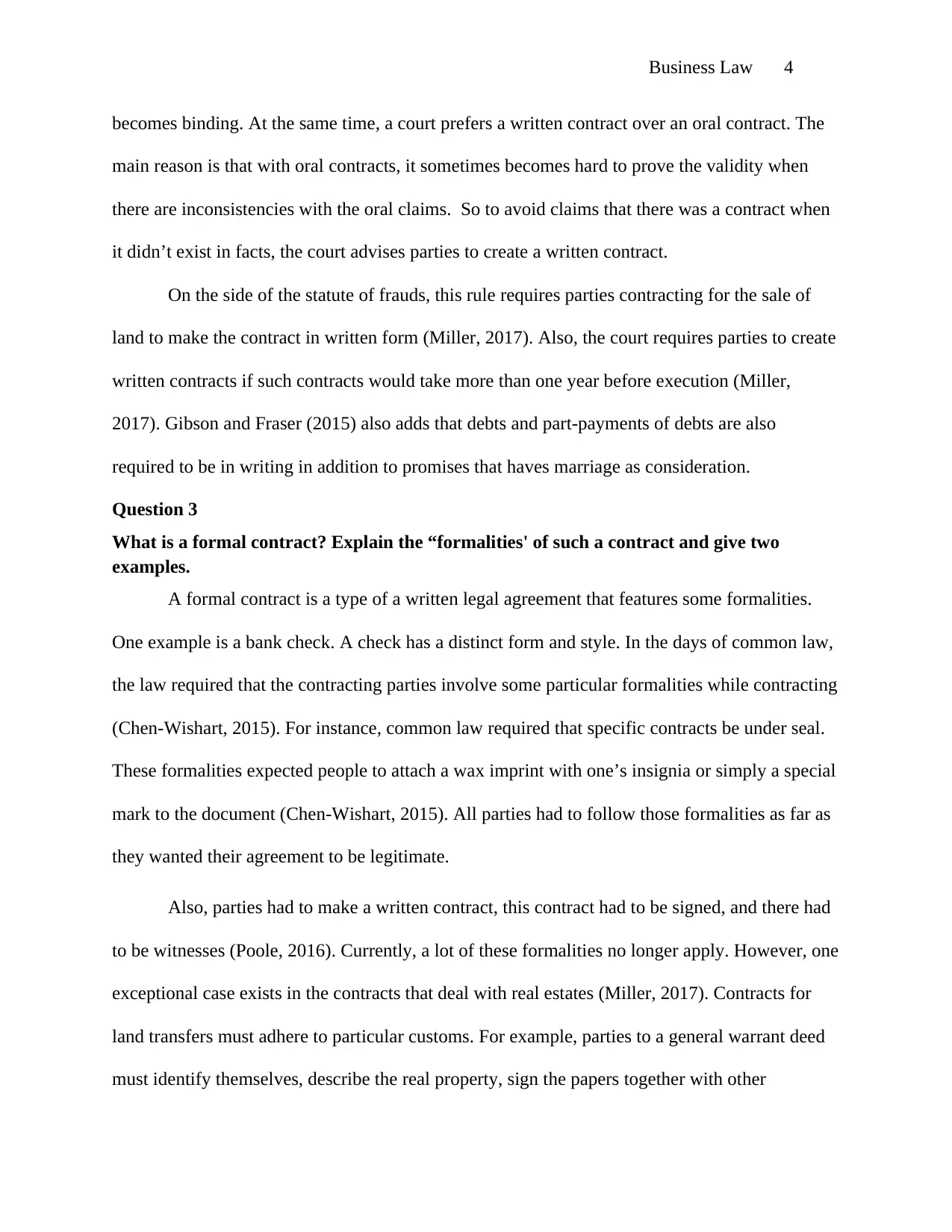
Business Law 4
becomes binding. At the same time, a court prefers a written contract over an oral contract. The
main reason is that with oral contracts, it sometimes becomes hard to prove the validity when
there are inconsistencies with the oral claims. So to avoid claims that there was a contract when
it didn’t exist in facts, the court advises parties to create a written contract.
On the side of the statute of frauds, this rule requires parties contracting for the sale of
land to make the contract in written form (Miller, 2017). Also, the court requires parties to create
written contracts if such contracts would take more than one year before execution (Miller,
2017). Gibson and Fraser (2015) also adds that debts and part-payments of debts are also
required to be in writing in addition to promises that haves marriage as consideration.
Question 3
What is a formal contract? Explain the “formalities' of such a contract and give two
examples.
A formal contract is a type of a written legal agreement that features some formalities.
One example is a bank check. A check has a distinct form and style. In the days of common law,
the law required that the contracting parties involve some particular formalities while contracting
(Chen-Wishart, 2015). For instance, common law required that specific contracts be under seal.
These formalities expected people to attach a wax imprint with one’s insignia or simply a special
mark to the document (Chen-Wishart, 2015). All parties had to follow those formalities as far as
they wanted their agreement to be legitimate.
Also, parties had to make a written contract, this contract had to be signed, and there had
to be witnesses (Poole, 2016). Currently, a lot of these formalities no longer apply. However, one
exceptional case exists in the contracts that deal with real estates (Miller, 2017). Contracts for
land transfers must adhere to particular customs. For example, parties to a general warrant deed
must identify themselves, describe the real property, sign the papers together with other
becomes binding. At the same time, a court prefers a written contract over an oral contract. The
main reason is that with oral contracts, it sometimes becomes hard to prove the validity when
there are inconsistencies with the oral claims. So to avoid claims that there was a contract when
it didn’t exist in facts, the court advises parties to create a written contract.
On the side of the statute of frauds, this rule requires parties contracting for the sale of
land to make the contract in written form (Miller, 2017). Also, the court requires parties to create
written contracts if such contracts would take more than one year before execution (Miller,
2017). Gibson and Fraser (2015) also adds that debts and part-payments of debts are also
required to be in writing in addition to promises that haves marriage as consideration.
Question 3
What is a formal contract? Explain the “formalities' of such a contract and give two
examples.
A formal contract is a type of a written legal agreement that features some formalities.
One example is a bank check. A check has a distinct form and style. In the days of common law,
the law required that the contracting parties involve some particular formalities while contracting
(Chen-Wishart, 2015). For instance, common law required that specific contracts be under seal.
These formalities expected people to attach a wax imprint with one’s insignia or simply a special
mark to the document (Chen-Wishart, 2015). All parties had to follow those formalities as far as
they wanted their agreement to be legitimate.
Also, parties had to make a written contract, this contract had to be signed, and there had
to be witnesses (Poole, 2016). Currently, a lot of these formalities no longer apply. However, one
exceptional case exists in the contracts that deal with real estates (Miller, 2017). Contracts for
land transfers must adhere to particular customs. For example, parties to a general warrant deed
must identify themselves, describe the real property, sign the papers together with other
Paraphrase This Document
Need a fresh take? Get an instant paraphrase of this document with our AI Paraphraser
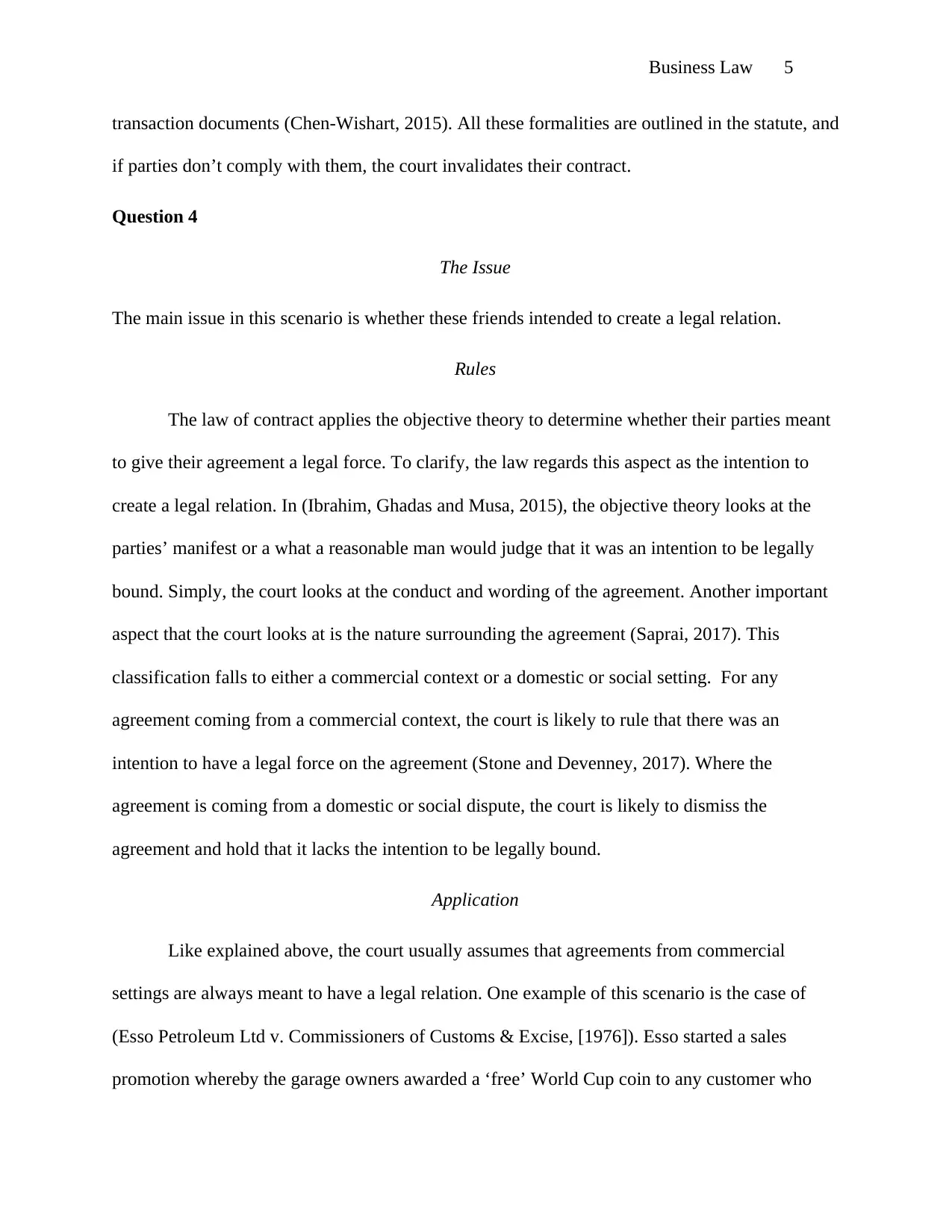
Business Law 5
transaction documents (Chen-Wishart, 2015). All these formalities are outlined in the statute, and
if parties don’t comply with them, the court invalidates their contract.
Question 4
The Issue
The main issue in this scenario is whether these friends intended to create a legal relation.
Rules
The law of contract applies the objective theory to determine whether their parties meant
to give their agreement a legal force. To clarify, the law regards this aspect as the intention to
create a legal relation. In (Ibrahim, Ghadas and Musa, 2015), the objective theory looks at the
parties’ manifest or a what a reasonable man would judge that it was an intention to be legally
bound. Simply, the court looks at the conduct and wording of the agreement. Another important
aspect that the court looks at is the nature surrounding the agreement (Saprai, 2017). This
classification falls to either a commercial context or a domestic or social setting. For any
agreement coming from a commercial context, the court is likely to rule that there was an
intention to have a legal force on the agreement (Stone and Devenney, 2017). Where the
agreement is coming from a domestic or social dispute, the court is likely to dismiss the
agreement and hold that it lacks the intention to be legally bound.
Application
Like explained above, the court usually assumes that agreements from commercial
settings are always meant to have a legal relation. One example of this scenario is the case of
(Esso Petroleum Ltd v. Commissioners of Customs & Excise, [1976]). Esso started a sales
promotion whereby the garage owners awarded a ‘free’ World Cup coin to any customer who
transaction documents (Chen-Wishart, 2015). All these formalities are outlined in the statute, and
if parties don’t comply with them, the court invalidates their contract.
Question 4
The Issue
The main issue in this scenario is whether these friends intended to create a legal relation.
Rules
The law of contract applies the objective theory to determine whether their parties meant
to give their agreement a legal force. To clarify, the law regards this aspect as the intention to
create a legal relation. In (Ibrahim, Ghadas and Musa, 2015), the objective theory looks at the
parties’ manifest or a what a reasonable man would judge that it was an intention to be legally
bound. Simply, the court looks at the conduct and wording of the agreement. Another important
aspect that the court looks at is the nature surrounding the agreement (Saprai, 2017). This
classification falls to either a commercial context or a domestic or social setting. For any
agreement coming from a commercial context, the court is likely to rule that there was an
intention to have a legal force on the agreement (Stone and Devenney, 2017). Where the
agreement is coming from a domestic or social dispute, the court is likely to dismiss the
agreement and hold that it lacks the intention to be legally bound.
Application
Like explained above, the court usually assumes that agreements from commercial
settings are always meant to have a legal relation. One example of this scenario is the case of
(Esso Petroleum Ltd v. Commissioners of Customs & Excise, [1976]). Esso started a sales
promotion whereby the garage owners awarded a ‘free’ World Cup coin to any customer who
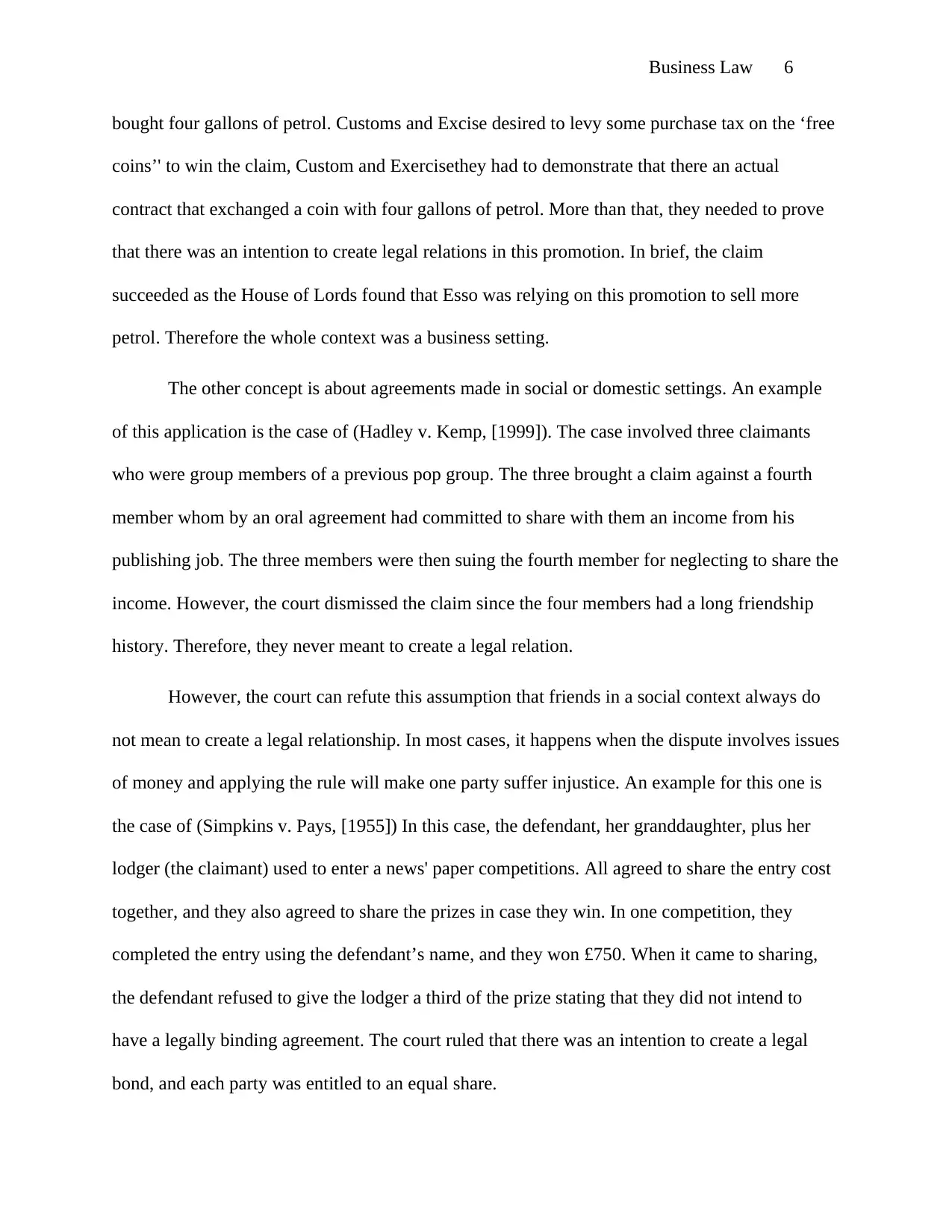
Business Law 6
bought four gallons of petrol. Customs and Excise desired to levy some purchase tax on the ‘free
coins’' to win the claim, Custom and Exercisethey had to demonstrate that there an actual
contract that exchanged a coin with four gallons of petrol. More than that, they needed to prove
that there was an intention to create legal relations in this promotion. In brief, the claim
succeeded as the House of Lords found that Esso was relying on this promotion to sell more
petrol. Therefore the whole context was a business setting.
The other concept is about agreements made in social or domestic settings. An example
of this application is the case of (Hadley v. Kemp, [1999]). The case involved three claimants
who were group members of a previous pop group. The three brought a claim against a fourth
member whom by an oral agreement had committed to share with them an income from his
publishing job. The three members were then suing the fourth member for neglecting to share the
income. However, the court dismissed the claim since the four members had a long friendship
history. Therefore, they never meant to create a legal relation.
However, the court can refute this assumption that friends in a social context always do
not mean to create a legal relationship. In most cases, it happens when the dispute involves issues
of money and applying the rule will make one party suffer injustice. An example for this one is
the case of (Simpkins v. Pays, [1955]) In this case, the defendant, her granddaughter, plus her
lodger (the claimant) used to enter a news' paper competitions. All agreed to share the entry cost
together, and they also agreed to share the prizes in case they win. In one competition, they
completed the entry using the defendant’s name, and they won £750. When it came to sharing,
the defendant refused to give the lodger a third of the prize stating that they did not intend to
have a legally binding agreement. The court ruled that there was an intention to create a legal
bond, and each party was entitled to an equal share.
bought four gallons of petrol. Customs and Excise desired to levy some purchase tax on the ‘free
coins’' to win the claim, Custom and Exercisethey had to demonstrate that there an actual
contract that exchanged a coin with four gallons of petrol. More than that, they needed to prove
that there was an intention to create legal relations in this promotion. In brief, the claim
succeeded as the House of Lords found that Esso was relying on this promotion to sell more
petrol. Therefore the whole context was a business setting.
The other concept is about agreements made in social or domestic settings. An example
of this application is the case of (Hadley v. Kemp, [1999]). The case involved three claimants
who were group members of a previous pop group. The three brought a claim against a fourth
member whom by an oral agreement had committed to share with them an income from his
publishing job. The three members were then suing the fourth member for neglecting to share the
income. However, the court dismissed the claim since the four members had a long friendship
history. Therefore, they never meant to create a legal relation.
However, the court can refute this assumption that friends in a social context always do
not mean to create a legal relationship. In most cases, it happens when the dispute involves issues
of money and applying the rule will make one party suffer injustice. An example for this one is
the case of (Simpkins v. Pays, [1955]) In this case, the defendant, her granddaughter, plus her
lodger (the claimant) used to enter a news' paper competitions. All agreed to share the entry cost
together, and they also agreed to share the prizes in case they win. In one competition, they
completed the entry using the defendant’s name, and they won £750. When it came to sharing,
the defendant refused to give the lodger a third of the prize stating that they did not intend to
have a legally binding agreement. The court ruled that there was an intention to create a legal
bond, and each party was entitled to an equal share.
⊘ This is a preview!⊘
Do you want full access?
Subscribe today to unlock all pages.

Trusted by 1+ million students worldwide
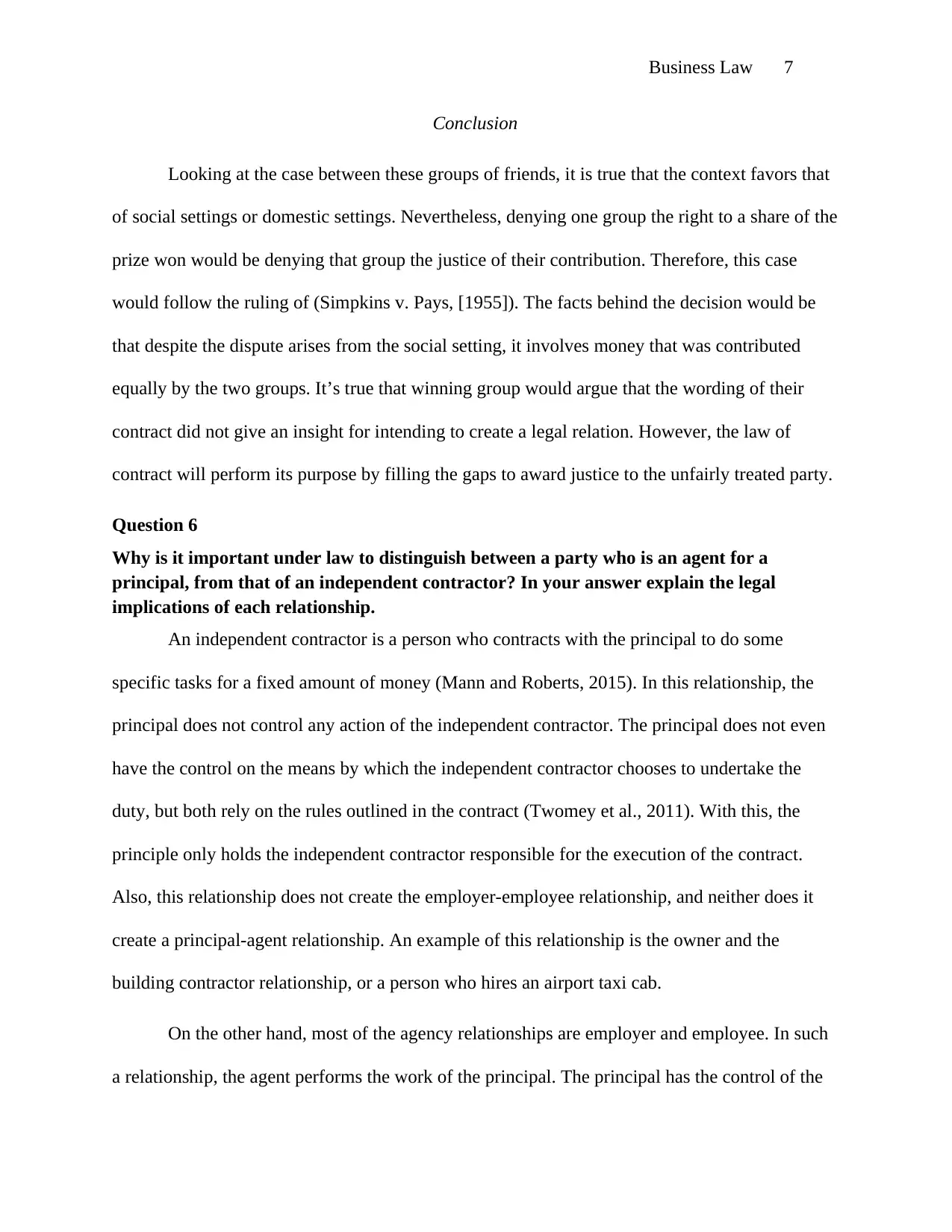
Business Law 7
Conclusion
Looking at the case between these groups of friends, it is true that the context favors that
of social settings or domestic settings. Nevertheless, denying one group the right to a share of the
prize won would be denying that group the justice of their contribution. Therefore, this case
would follow the ruling of (Simpkins v. Pays, [1955]). The facts behind the decision would be
that despite the dispute arises from the social setting, it involves money that was contributed
equally by the two groups. It’s true that winning group would argue that the wording of their
contract did not give an insight for intending to create a legal relation. However, the law of
contract will perform its purpose by filling the gaps to award justice to the unfairly treated party.
Question 6
Why is it important under law to distinguish between a party who is an agent for a
principal, from that of an independent contractor? In your answer explain the legal
implications of each relationship.
An independent contractor is a person who contracts with the principal to do some
specific tasks for a fixed amount of money (Mann and Roberts, 2015). In this relationship, the
principal does not control any action of the independent contractor. The principal does not even
have the control on the means by which the independent contractor chooses to undertake the
duty, but both rely on the rules outlined in the contract (Twomey et al., 2011). With this, the
principle only holds the independent contractor responsible for the execution of the contract.
Also, this relationship does not create the employer-employee relationship, and neither does it
create a principal-agent relationship. An example of this relationship is the owner and the
building contractor relationship, or a person who hires an airport taxi cab.
On the other hand, most of the agency relationships are employer and employee. In such
a relationship, the agent performs the work of the principal. The principal has the control of the
Conclusion
Looking at the case between these groups of friends, it is true that the context favors that
of social settings or domestic settings. Nevertheless, denying one group the right to a share of the
prize won would be denying that group the justice of their contribution. Therefore, this case
would follow the ruling of (Simpkins v. Pays, [1955]). The facts behind the decision would be
that despite the dispute arises from the social setting, it involves money that was contributed
equally by the two groups. It’s true that winning group would argue that the wording of their
contract did not give an insight for intending to create a legal relation. However, the law of
contract will perform its purpose by filling the gaps to award justice to the unfairly treated party.
Question 6
Why is it important under law to distinguish between a party who is an agent for a
principal, from that of an independent contractor? In your answer explain the legal
implications of each relationship.
An independent contractor is a person who contracts with the principal to do some
specific tasks for a fixed amount of money (Mann and Roberts, 2015). In this relationship, the
principal does not control any action of the independent contractor. The principal does not even
have the control on the means by which the independent contractor chooses to undertake the
duty, but both rely on the rules outlined in the contract (Twomey et al., 2011). With this, the
principle only holds the independent contractor responsible for the execution of the contract.
Also, this relationship does not create the employer-employee relationship, and neither does it
create a principal-agent relationship. An example of this relationship is the owner and the
building contractor relationship, or a person who hires an airport taxi cab.
On the other hand, most of the agency relationships are employer and employee. In such
a relationship, the agent performs the work of the principal. The principal has the control of the
Paraphrase This Document
Need a fresh take? Get an instant paraphrase of this document with our AI Paraphraser
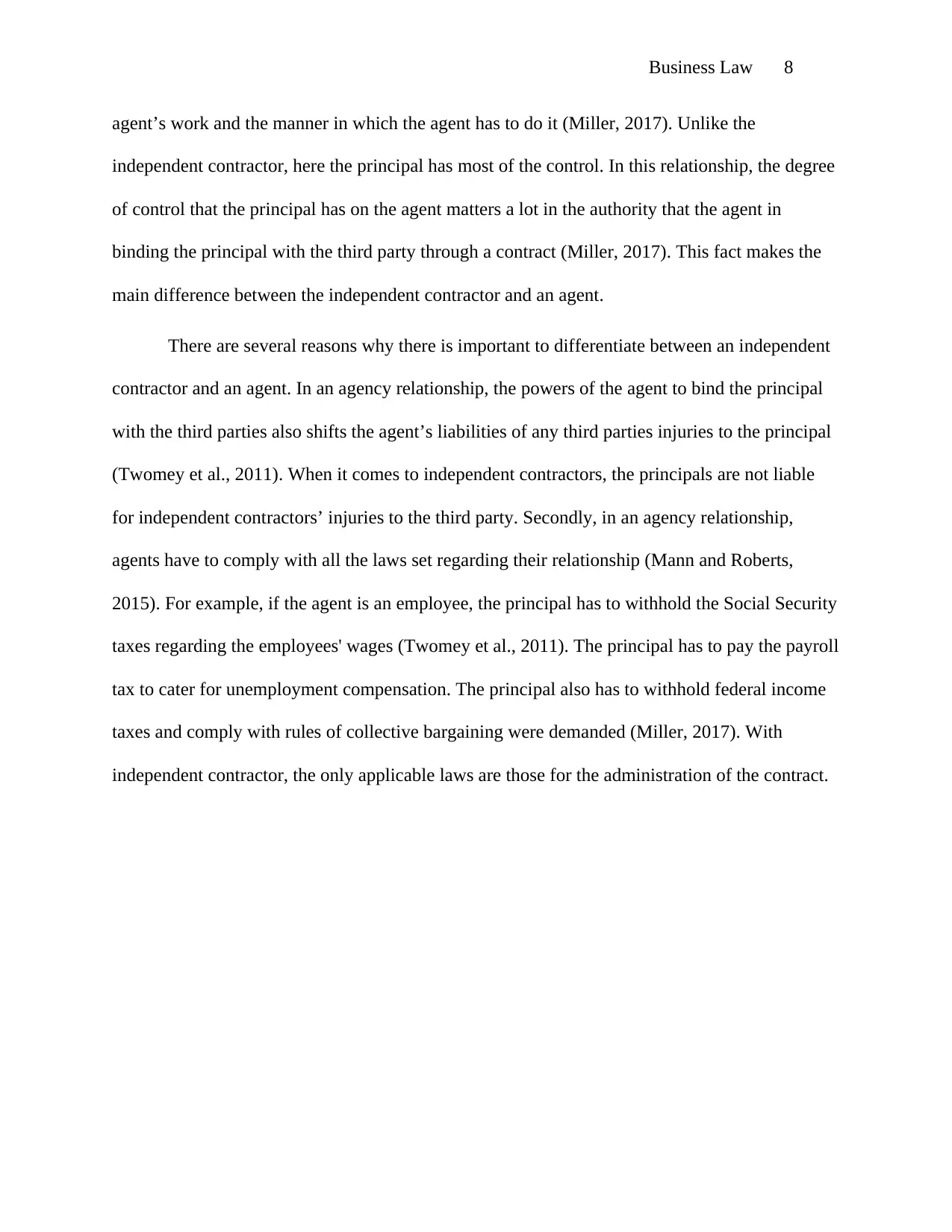
Business Law 8
agent’s work and the manner in which the agent has to do it (Miller, 2017). Unlike the
independent contractor, here the principal has most of the control. In this relationship, the degree
of control that the principal has on the agent matters a lot in the authority that the agent in
binding the principal with the third party through a contract (Miller, 2017). This fact makes the
main difference between the independent contractor and an agent.
There are several reasons why there is important to differentiate between an independent
contractor and an agent. In an agency relationship, the powers of the agent to bind the principal
with the third parties also shifts the agent’s liabilities of any third parties injuries to the principal
(Twomey et al., 2011). When it comes to independent contractors, the principals are not liable
for independent contractors’ injuries to the third party. Secondly, in an agency relationship,
agents have to comply with all the laws set regarding their relationship (Mann and Roberts,
2015). For example, if the agent is an employee, the principal has to withhold the Social Security
taxes regarding the employees' wages (Twomey et al., 2011). The principal has to pay the payroll
tax to cater for unemployment compensation. The principal also has to withhold federal income
taxes and comply with rules of collective bargaining were demanded (Miller, 2017). With
independent contractor, the only applicable laws are those for the administration of the contract.
agent’s work and the manner in which the agent has to do it (Miller, 2017). Unlike the
independent contractor, here the principal has most of the control. In this relationship, the degree
of control that the principal has on the agent matters a lot in the authority that the agent in
binding the principal with the third party through a contract (Miller, 2017). This fact makes the
main difference between the independent contractor and an agent.
There are several reasons why there is important to differentiate between an independent
contractor and an agent. In an agency relationship, the powers of the agent to bind the principal
with the third parties also shifts the agent’s liabilities of any third parties injuries to the principal
(Twomey et al., 2011). When it comes to independent contractors, the principals are not liable
for independent contractors’ injuries to the third party. Secondly, in an agency relationship,
agents have to comply with all the laws set regarding their relationship (Mann and Roberts,
2015). For example, if the agent is an employee, the principal has to withhold the Social Security
taxes regarding the employees' wages (Twomey et al., 2011). The principal has to pay the payroll
tax to cater for unemployment compensation. The principal also has to withhold federal income
taxes and comply with rules of collective bargaining were demanded (Miller, 2017). With
independent contractor, the only applicable laws are those for the administration of the contract.
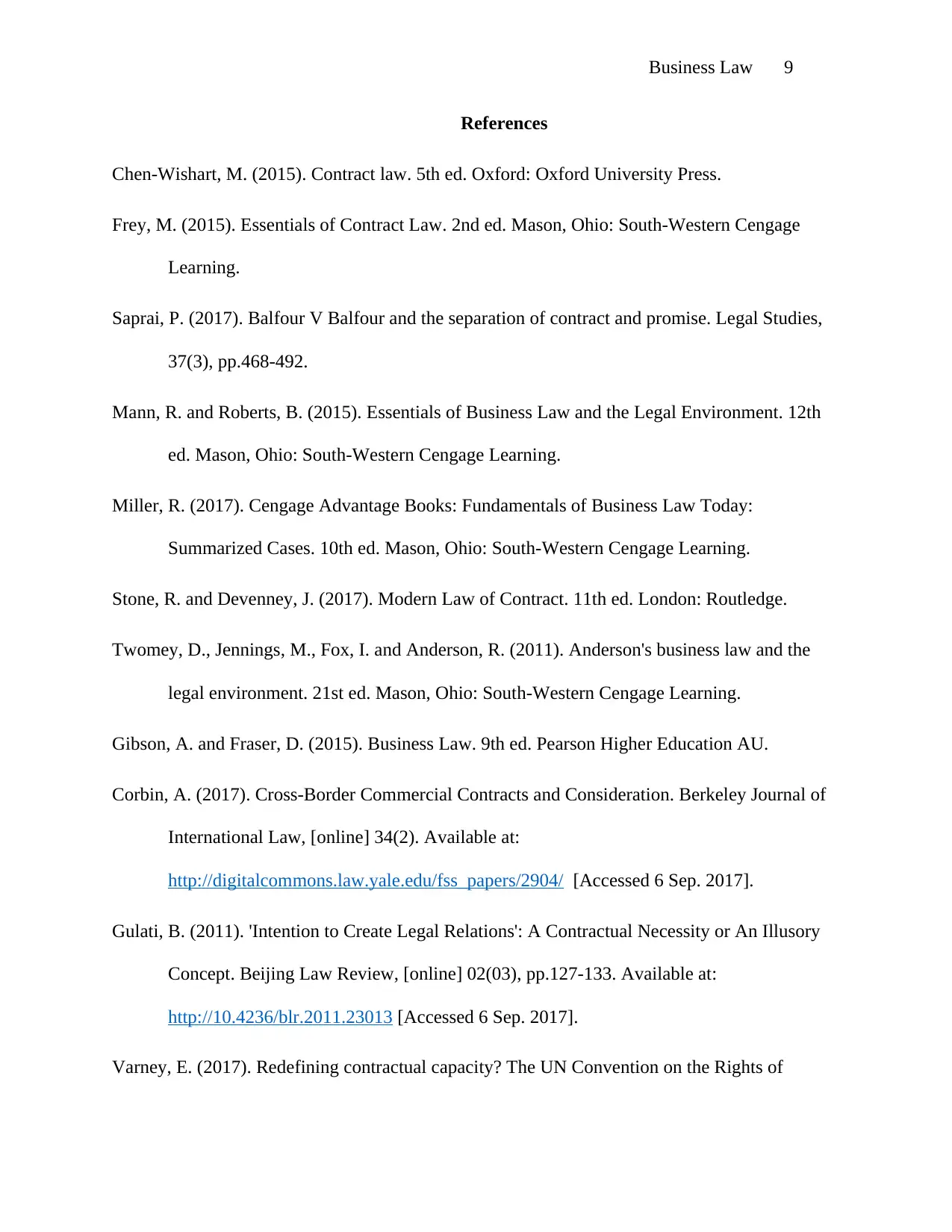
Business Law 9
References
Chen-Wishart, M. (2015). Contract law. 5th ed. Oxford: Oxford University Press.
Frey, M. (2015). Essentials of Contract Law. 2nd ed. Mason, Ohio: South-Western Cengage
Learning.
Saprai, P. (2017). Balfour V Balfour and the separation of contract and promise. Legal Studies,
37(3), pp.468-492.
Mann, R. and Roberts, B. (2015). Essentials of Business Law and the Legal Environment. 12th
ed. Mason, Ohio: South-Western Cengage Learning.
Miller, R. (2017). Cengage Advantage Books: Fundamentals of Business Law Today:
Summarized Cases. 10th ed. Mason, Ohio: South-Western Cengage Learning.
Stone, R. and Devenney, J. (2017). Modern Law of Contract. 11th ed. London: Routledge.
Twomey, D., Jennings, M., Fox, I. and Anderson, R. (2011). Anderson's business law and the
legal environment. 21st ed. Mason, Ohio: South-Western Cengage Learning.
Gibson, A. and Fraser, D. (2015). Business Law. 9th ed. Pearson Higher Education AU.
Corbin, A. (2017). Cross-Border Commercial Contracts and Consideration. Berkeley Journal of
International Law, [online] 34(2). Available at:
http://digitalcommons.law.yale.edu/fss_papers/2904/ [Accessed 6 Sep. 2017].
Gulati, B. (2011). 'Intention to Create Legal Relations': A Contractual Necessity or An Illusory
Concept. Beijing Law Review, [online] 02(03), pp.127-133. Available at:
http://10.4236/blr.2011.23013 [Accessed 6 Sep. 2017].
Varney, E. (2017). Redefining contractual capacity? The UN Convention on the Rights of
References
Chen-Wishart, M. (2015). Contract law. 5th ed. Oxford: Oxford University Press.
Frey, M. (2015). Essentials of Contract Law. 2nd ed. Mason, Ohio: South-Western Cengage
Learning.
Saprai, P. (2017). Balfour V Balfour and the separation of contract and promise. Legal Studies,
37(3), pp.468-492.
Mann, R. and Roberts, B. (2015). Essentials of Business Law and the Legal Environment. 12th
ed. Mason, Ohio: South-Western Cengage Learning.
Miller, R. (2017). Cengage Advantage Books: Fundamentals of Business Law Today:
Summarized Cases. 10th ed. Mason, Ohio: South-Western Cengage Learning.
Stone, R. and Devenney, J. (2017). Modern Law of Contract. 11th ed. London: Routledge.
Twomey, D., Jennings, M., Fox, I. and Anderson, R. (2011). Anderson's business law and the
legal environment. 21st ed. Mason, Ohio: South-Western Cengage Learning.
Gibson, A. and Fraser, D. (2015). Business Law. 9th ed. Pearson Higher Education AU.
Corbin, A. (2017). Cross-Border Commercial Contracts and Consideration. Berkeley Journal of
International Law, [online] 34(2). Available at:
http://digitalcommons.law.yale.edu/fss_papers/2904/ [Accessed 6 Sep. 2017].
Gulati, B. (2011). 'Intention to Create Legal Relations': A Contractual Necessity or An Illusory
Concept. Beijing Law Review, [online] 02(03), pp.127-133. Available at:
http://10.4236/blr.2011.23013 [Accessed 6 Sep. 2017].
Varney, E. (2017). Redefining contractual capacity? The UN Convention on the Rights of
⊘ This is a preview!⊘
Do you want full access?
Subscribe today to unlock all pages.

Trusted by 1+ million students worldwide
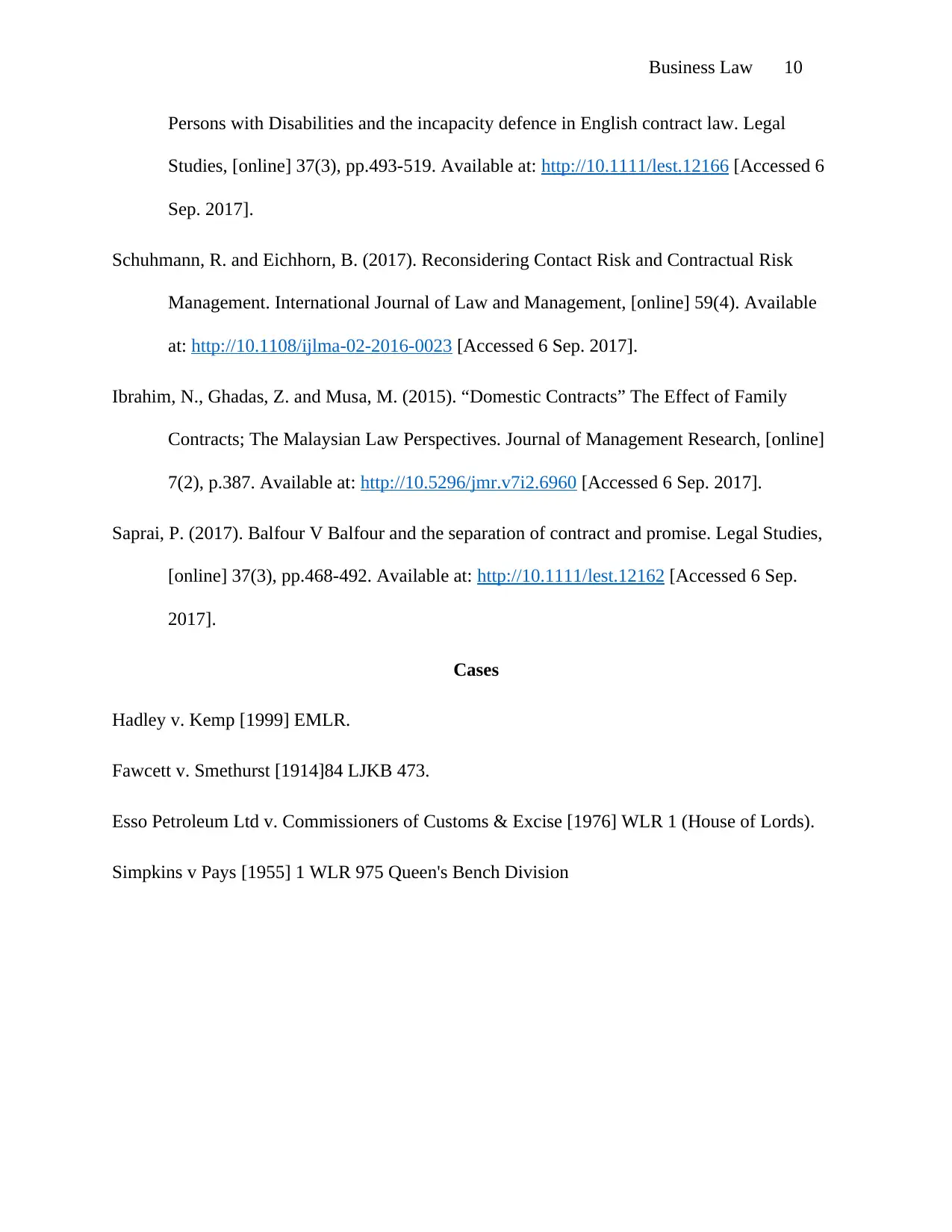
Business Law 10
Persons with Disabilities and the incapacity defence in English contract law. Legal
Studies, [online] 37(3), pp.493-519. Available at: http://10.1111/lest.12166 [Accessed 6
Sep. 2017].
Schuhmann, R. and Eichhorn, B. (2017). Reconsidering Contact Risk and Contractual Risk
Management. International Journal of Law and Management, [online] 59(4). Available
at: http://10.1108/ijlma-02-2016-0023 [Accessed 6 Sep. 2017].
Ibrahim, N., Ghadas, Z. and Musa, M. (2015). “Domestic Contracts” The Effect of Family
Contracts; The Malaysian Law Perspectives. Journal of Management Research, [online]
7(2), p.387. Available at: http://10.5296/jmr.v7i2.6960 [Accessed 6 Sep. 2017].
Saprai, P. (2017). Balfour V Balfour and the separation of contract and promise. Legal Studies,
[online] 37(3), pp.468-492. Available at: http://10.1111/lest.12162 [Accessed 6 Sep.
2017].
Cases
Hadley v. Kemp [1999] EMLR.
Fawcett v. Smethurst [1914]84 LJKB 473.
Esso Petroleum Ltd v. Commissioners of Customs & Excise [1976] WLR 1 (House of Lords).
Simpkins v Pays [1955] 1 WLR 975 Queen's Bench Division
Persons with Disabilities and the incapacity defence in English contract law. Legal
Studies, [online] 37(3), pp.493-519. Available at: http://10.1111/lest.12166 [Accessed 6
Sep. 2017].
Schuhmann, R. and Eichhorn, B. (2017). Reconsidering Contact Risk and Contractual Risk
Management. International Journal of Law and Management, [online] 59(4). Available
at: http://10.1108/ijlma-02-2016-0023 [Accessed 6 Sep. 2017].
Ibrahim, N., Ghadas, Z. and Musa, M. (2015). “Domestic Contracts” The Effect of Family
Contracts; The Malaysian Law Perspectives. Journal of Management Research, [online]
7(2), p.387. Available at: http://10.5296/jmr.v7i2.6960 [Accessed 6 Sep. 2017].
Saprai, P. (2017). Balfour V Balfour and the separation of contract and promise. Legal Studies,
[online] 37(3), pp.468-492. Available at: http://10.1111/lest.12162 [Accessed 6 Sep.
2017].
Cases
Hadley v. Kemp [1999] EMLR.
Fawcett v. Smethurst [1914]84 LJKB 473.
Esso Petroleum Ltd v. Commissioners of Customs & Excise [1976] WLR 1 (House of Lords).
Simpkins v Pays [1955] 1 WLR 975 Queen's Bench Division
1 out of 10
Related Documents
Your All-in-One AI-Powered Toolkit for Academic Success.
+13062052269
info@desklib.com
Available 24*7 on WhatsApp / Email
![[object Object]](/_next/static/media/star-bottom.7253800d.svg)
Unlock your academic potential
Copyright © 2020–2025 A2Z Services. All Rights Reserved. Developed and managed by ZUCOL.





